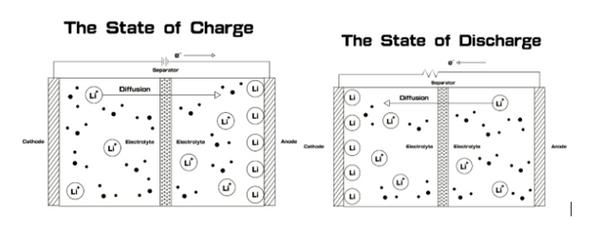This article explores the use of lithium-iron phosphate batteries in off-grid CB & Ham radio operation. LiFePO4 batteries offer an excellent portable energy source option for setups where you do not have access to plug in AC and can often be recharged easily with cheap solar energy. Spec parameter comparisons with batteries of different chemistries such as sealed lead acid batteries and other lithium-ion batteries will also be carried out. Typically, in most applications, ham radios require nominal voltages of around 13.8V DC, this is often given by batteries of 12V. Batteries in higher states of charge usually have more voltage than the nominal rated voltage.
Brief detail on LiFePO4 Structure and Working Principle
LiFePO4 batteries, similar to every battery type, have an anode, cathode and a separator membrane. The cathode contains a metallic oxide in this case, lithium-ion phosphate while the anode is made from graphite. The separator exists to electrically separate the two terminals and for selective ionic movement.
During charging, the potential (read voltage) electrons are ‘knocked’ out of the cathode and move towards the anode. The separator only allows positive Lithium ions to pass through it where they recombine with the electrons to form lithiated graphite at the anode. During discharge, the reverse happens, the electrons move from the anode to the cathode. It is this free movement of electrons between the anode and cathode that gives the energy to power loads.

a) Diagram detailing the charging vs discharging process in Lithium type batteries. Graphic adapted from Hopax
Ham Radio Power Requirements
Proper selection of power supply sources is important in ham radio operation, sufficient knowledge of Tx and Rx current requirements of your radio is critical as well. Power supply sources are usually rated according to continuous current capacity, peak current capacity and ampere-hour (Ah) ratings. Ah ratings determine how long the power source is able to power your transceiver. Types of ham radio power supplies in existence are: Linear and Switching power supplies.
"Linear" power supplies are the most common of the two and have been around for a longer time period. They take in AC power usually at 110/230V from a plug in socket and step it down through a step down transformer. A rectifier then converts the stepped down AC to DC power. This DC power is passed through a DC-link, where it is filtered to produce clean and stable 12V DC for ham radio application. Linear power supplies provide a reliable and stable source of power free from EMI and RFI interference. The downside to them is that they can be really bulky and heavy to carry around due to its large heat sinks and components that form it. They are quite pricey as well.

b) Linear (L) vs Switching power supply (R), Graphic adapted from Two way
In "Switching" power supplies, conversion of AC input to DC transpires instantaneously, yet it does not undergo an immediate reduction in voltage. Instead, the high voltage DC is directed into a switching transistor. This transistor, through rapid switching at a considerably high frequency (in the kilohertz range), essentially reverts the DC back into AC. Subsequently, it proceeds as a conventional linear power supply. The high-frequency AC traverses a transformer to transform into low voltage AC, undergoes rectification, filtration, and is ultimately supplied to your radio. These provide a lightweight alternative to traditional linear power supplies, and they are generally more cost-effective. However, this type of power supply can introduce noise and interference on specific ham radio frequency bands due to the switching action of transistors. While some switching supplies are designed effectively to manage and suppress this noise, there are also budget-friendly options that are susceptible to interference issues.
A third alternative in terms of power supplies, which serves as the motivation behind this article, involves using batteries to energize ham radios. More precisely, LiFePO4 batteries offer the capacity to support off-grid ham radio operation through use of compact module-based LiFePO4 batteries. They enable the powering of your entire system, even in a ham radio station at home, by using higher-capacity LiFePO4 batteries. A popular battery choice is the high quality LEV60 12v LiFePO4 batteries.
Advantages of using LiFePO4 Batteries for Ham Radio Broadcasting
- Energy density. LiFePO4 batteries have an energy density of around 130 - 170 Wh/Kg while SLA batteries have an energy density of between 30 -50 Wh/Kg. They therefore provide an excellent compact portable power supply, this is important for off grid ham radio operation. It can also be used in off grid set ups to provide power for other devices requiring 12V DC and can easily be recharged with solar. Their use offers flexibility.
- Low self discharge, approximated at less than 5% a month. No capacity is lost even under storage.
- Higher discharge and charge cycles, it is estimated to be around 3000 cycles with high quality batteries with as high as 6000 cycles. This translates to longer battery lifetime.
- High discharge capacity, one of the major specs to look at is peak current requirement for transceivers. With proper sizing and power supply selection, LiFePO4 batteries can easily handle excess current without much voltage sag at the terminals.
- Studying the Voltage vs SOC chart and plots, for the majority of its discharging cycle, from a 100% to 20% SOC, the LiFePO4 maintains an almost constant voltage level of between 3.2 to 3.35 Volts. This is ideal for ham radio based applications.
- The use of batteries as a power source mitigates the potential sources of noise originating from conventional power supplies especially the switched power supplies.
Conclusion
This article delved into the fundamental structure and operational principles of LiFePO4 batteries. It also explored the traditional power sources commonly used in ham and CB radio setups. Furthermore, this article has highlighted the benefits of employing a stand alone battery system to supply power. From the discussion it is clear that LiFePO4 batteries offer a reliable, flexible, and cost-effective solution for off-grid ham radio applications. Consider using these popular LEV60 12v LiFePO4 batteries on your CB & HAM Radio devices, available on JAG35.
Article contributed to JAG35, written by Japhet K, Electrical Engineer at http://charged-engineering.com

